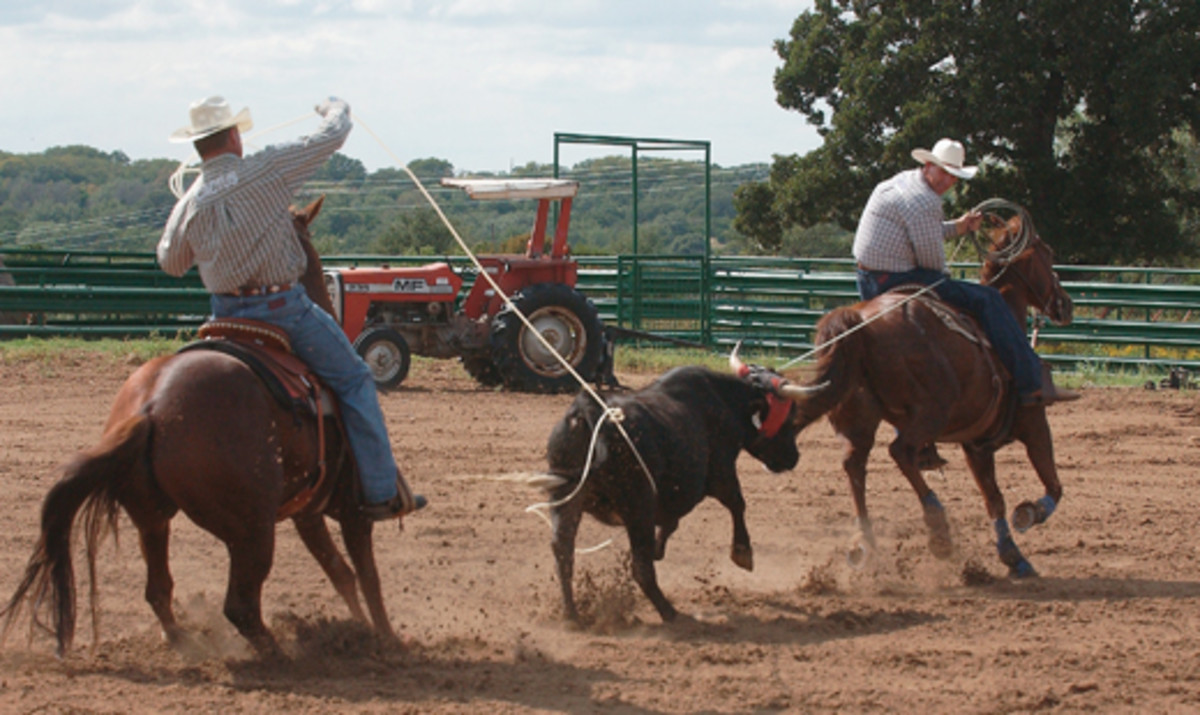
There’s a humorous saying that I’ve used for years about different guys I’ve roped with, mostly Jake, that “I just throw my loop down there and he pulls them in it.” Trying to get your header to pull steers into your loop is just another way of saying there has to be communication between the header and heeler on how to make the run come together to where the heeler knows what’s going to happen on the handle. You need to let your header know what works best for you as a heeler. That all takes communication.
When I was starting out as a kid-and even coming up through the amateur ranks and getting our cards and jackpotting-I can remember for the longest time nobody ever mentioning or communicating that much about how the steer needed to be handled or what would work best for me as a heeler. It seemed like it was maybe even up until I started roping with Jake in 1985 before we really started discussing our roping and breaking it down as a team. That’s the first time I communicated with a partner how I wanted a steer to be handled.
I get a lot of questions asked from time to time, heeler to heeler, about how I like my cattle handled. A lot of guys have problems communicating with their headers how they like steers handled. I get a lot of headers asking me how I like steers handled, too, when they rope with a lot of different heelers. I’m kind of like a sounding board, so they can come up with which would be the best way to handle cattle if they’re getting lots of different requests from their different partners.
Listening to the way a lot of lower- to mid-range-numbered ropers communicate with one another, the headers and heelers assume there’s just one way to handle a steer. But each situation can differ, based on factors like freshness of the cattle, how hard the cattle run and arena dimensions. Those things need to be factored in, and a header needs to handle cattle differently under different conditions.
Some of the pro headers that I’ve talked to about handling steers realize there are different handles for different situations. And in building a good team, it takes communicating with each other about those different situations that you’re going to get into. From there, going over the game plan together is beneficial so you’re on the same page before you run each steer.
For instance, while we’re writing this article we’re waiting to rope our first steer at Salinas. (Editor’s note: The original article was written in 2004.) It’s an extreme situation. The cattle are scored 35 feet, and your horses and the steer are running as hard as they can run. Under those conditions and considering it’s a five-steer average, you have to try to set up a consistent run.
The header’s handle is going to be a very important part of setting up that run. When a steer’s running as hard as he can run, you can’t just change directions with him and expect him to handle very well for the heeler. The header has to take some time bringing the steer around and slowing things down before he moves to the left to set up a good, easy shot for the heeler.
On the other end of the spectrum, you may be at a place where you run slower, roped-out cattle over a shorter score. The same type of handle under those conditions would just cost you time and mess up the run.
Under those slower conditions, because the cattle are worn out they already know how to take the corner and handle pressure from the head rope. So a header can make his move a lot quicker to the left, get out in front of a steer and keep things rolling through the turn.
Opportunities in Team Roping Today are Sky High with Jake Barnes
When you run into obstacles on either side, whether you’re a header or heeler, because of characteristics from one or the other’s horse and how that horse might be one-dimensional in the way he works, sometimes you have to meet your partner in the middle and do the best you can to provide change on your end to compensate for that one-dimensional horse.
For example, if your header’s horse is a little bit out of control in the corner and there’s not much he can do about it for the time being, you’re just going to have to bow up, ride in there and pull off some shots. And if the steers don’t handle very good, be sympathetic that you know your partner’s doing the best he can under the conditions he’s dealt.
Over the past 20-some-odd years of rodeoing professionally, I’ve seen headers and heelers that were always critical of their partners, no matter who they roped with. I feel there’s a way to communicate with every partner to give him or her an idea of what would be best for you, but also keep his confidence built up so he’s always trying and knowing you have confidence in him.
The way you communicate with your partner is the key to success. I’ve roped with some guys who gave me the feeling that they didn’t have confidence in what I did, and other guys who built me up and gave me a lot of confidence, even in the midst of a slump. I know I appreciate being built up. It makes me try harder. And as you can see here, Jake knows exactly how to drag one into my loop.










